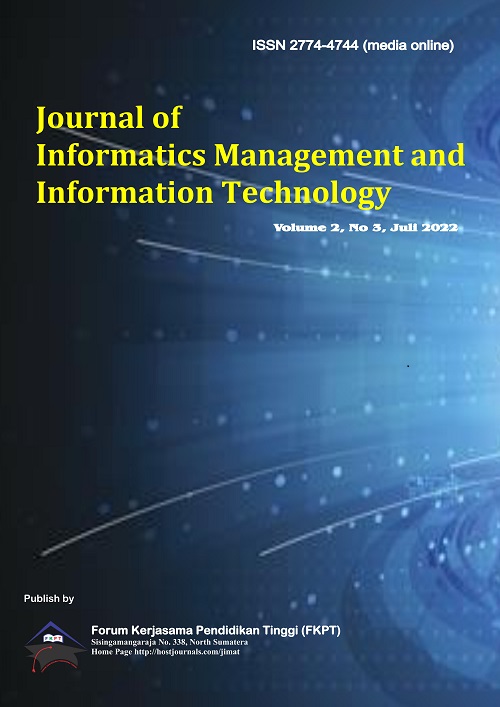Audit Sistem Informasi Absensi Pada MI Miftahul Ulum Menggunakan Cobit 4.1
DOI:
https://doi.org/10.47065/jimat.v2i3.168Keywords:
Audit; Cobit 4.1; Attendance; Domain; GAPAbstract
This study aims to determine the extent to which the company implement IT governance. The focus of this research is on the COBIT 4.1 domain, namely PO1, PO4, PO9, DS5, DS9, DS12, and ME. The method is based on COBIT 4.1, this research uses several stages, namely literature review, data collection, and data processing at MI Miftahul Ulum. The results of data processing are used to find weaknesses in each domain. Weaknesses or problems compared to the ideal conditions that have been set for the COBIT 4.1 audit framework at each level, the problem encountered at MI Miftahul Ulum is that there are still problems with the attendance system, problems often occur such as not being read by the system even though they have made attendance which results in reduced attendance. teacher appraisals and salaries. The results of the calculation of the largest maturity level in the DS12 domain with a maturity level value of 3.89, must be increased again, while the smallest value in the PO1 domain with a maturity level value of 3.15 must be repaired again so that the attendance system is as expected.
Downloads
References
S. Kasus et al., “Penggunaan COBIT 4 . 1 Dengan Domain ME Pada Sistem Informasi Absensi Penggunaan COBIT 4 . 1 Dengan Domain ME Pada Sistem Informasi Absensi ( Studi Kasus?: Universitas XYZ ),” no. September, 2018, doi: 10.30872/jim.v13i2.1152.
A. Menggunakan, K. Kerja, M. Angelia, Y. Setevannus, and J. F. Andry, “AUDIT SISTEM INFORMASI ABSENSI PADA PT SINAR PRATAMA,” vol. 4, no. 2, pp. 163–171, 2018.
I. B. Sukmajaya and Johanes Fernandes Andry, “Audit Sistem Informasi Pada Aplikasi Accurate Menggunakan Model Cobit Framework 4.1 (Studi Kasus: PT. Setia Jaya Teknologi),” Semin. Nas. Teknoka, vol. 2, no. 2502–8782, pp. 42–51, 2017.
Zuraidah Eva;budihartanti Cahyani, Audit Sistem Informasi dan Manajemen Menggunakan Cobit 4 dan 5. Yogyakarta: Graha Ilmu, 2021.
i putu agus; I. gusti lanang agung raditia putra Swastika, Audit Sistem Informasi dnan Tata Kelola Tekhnologi Informasi Implementasi dan Studi Kasus. Yogyakarta: CV. Andi Offside, 2016.
P. D. Sugiuono, METODE PENELITIAN Kuantitatif, Kualitatif, dan R&D, Ke-3. Bandung: Alfabeta, 2021.
C. Domain, D. S. Me, and D. I. Dinas, “Informasi Menggunakan Framework,” vol. 1, no. 1, pp. 32–39, 2020.
J. F. O. Andry Jeffry; Khotama, Michael; Chandra, Agustinus; Gunawan, Catherine Kurniadi, “Audit Fingerprint pada PT X dengan Framework COBIT 4.1,” J. Inform. dan Sist. Inf., vol. 04, no. Vol 4 No 1 (2018): Jurnal Informatika dan Sistem Informasi, pp. 34–43, 2018, [Online]. Available: https://journal.uc.ac.id/index.php/JUISI/article/view/693.
Winalia1, F. Renaldi, and A. I. Hadiana, “Pengukuran Tingkat Kematangan Teknologi Informasi Menggunakan Cobit 4.1 Pada Universitas Jenderal Achmad Yani,” Semin. Nas. Apl. Teknol. Inf., no. 1907–5022, pp. 31–36, 2017.
S. Royal, “PENERAPAN DOMAIN MONITOR AND EVALUATE FRAMEWORK COBIT 4 . 1 DALAM PELAKSANAAN AUDIT SISTEM INFORMASI,” vol. 4307, no. June, pp. 205–211, 2021.
A. Risiko, P. Proses, and P. Pabrik, “Jurnal Comasie Jurnal Comasie,” vol. 4, pp. 60–68, 2021.
Bila bermanfaat silahkan share artikel ini
Berikan Komentar Anda terhadap artikel Audit Sistem Informasi Absensi Pada MI Miftahul Ulum Menggunakan Cobit 4.1
ARTICLE HISTORY
Issue
Section
Copyright (c) 2022 M. Irfandi, Eva Zuraidah

This work is licensed under a Creative Commons Attribution 4.0 International License.
Authors who publish with this journal agree to the following terms:
- Authors retain copyright and grant the journal right of first publication with the work simultaneously licensed under Creative Commons Attribution 4.0 International License that allows others to share the work with an acknowledgment of the work's authorship and initial publication in this journal.
- Authors are able to enter into separate, additional contractual arrangements for the non-exclusive distribution of the journal's published version of the work (e.g., post it to an institutional repository or publish it in a book), with an acknowledgment of its initial publication in this journal.
- Authors are permitted and encouraged to post their work online (e.g., in institutional repositories or on their website) prior to and during the submission process, as it can lead to productive exchanges, as well as earlier and greater citation of published work (Refer to The Effect of Open Access).















